

Five Best Practices Teachers Can Learn from Dungeon Masters. Sarah Roman, who uses D&D with high school English students, draws parallels between the work of DMs and teachers.
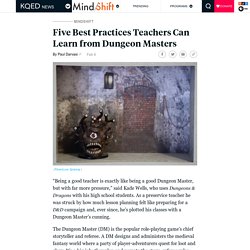
“You essentially progress with the same practices and ideas for getting a group of people to come together to work towards a common goal,” said Roman. “You set aside time to craft a campaign (lessons), put in roadblocks and problems (individual lessons), craft puzzles and dungeons that scale in difficulty (tests), all while making sure to understand the people with whom you’re working. In both cases, you become the leader and entryway to a world that they’ve never experienced.”
Michael Matera, who runs his middle-school social studies classes as games synthesizes lesson planning with game design. “When you think about the central points to building a good game, they share many with the core strategies for building successful instruction,” said Matera. Stories shape our self-perception, help us organize knowledge and make sense of a chaotic world.
Turning Your Students Into Web Detectives. Our students use the web every day—shouldn’t we expect them to do better at interpreting what they read there? Perhaps, but not necessarily. Often, stereotypes about kids and technology can get in the way of what’s at stake in today’s complex media landscape. Alternatives To Homework: A Chart For Teachers. Edutopia. Writing is complicated. Depending on the study you read, strong writing requires a mastery of 28, 34, or 47 distinct skills. The fact that researchers can’t even agree on how many traits go into writing illustrates just how complicated it is. That makes the teaching of writing really complicated—writing teachers need to understand this complex skill and find a way to pass it on to 140 or more students, each with his or her own blend of prior knowledge, writing ability, and motivation. Faced with such a Herculean task, writing teachers need to be as efficient and effective as possible.
The good news is that a number of best practices have emerged in recent years that allow writing teachers to significantly improve their practice without adding more hours to already overfilled days. Write More Most writing researchers and teachers of note now advise that students should write between 30 and 60 minutes every day. Grade Less. A Handy Google Scholar Search Refinement Tool.
7 Time Savers for Innovative Educators. The one thing all innovative educators need is more time.
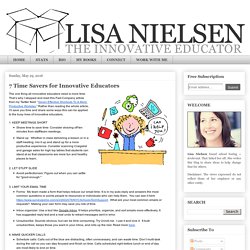
That’s why I stopped and read this Fast Company article from my Twitter feed: “Seven Effective Shortcuts To A More Productive Workday.” Rather than reading the whole article, I’ll save you time and share some ways this can be applied to the busy lives of innovative educators. Shave time to save time: Consider shaving off ten minutes from staff/team meetings. How to Use Apostrophes (Infographic) – The Visual Communication Guy: Design, Writing, and Teaching Resources All in One Place! As I passed a billboard this week, telling me the “do’s and dont’s” of something or other–I can’t even recall what the billboard was about because I was so distracted by the error–I was reminded how frequently we see apostrophe errors in all kinds of professional settings.
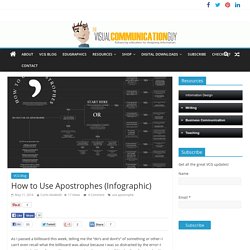
(By the way, the billboard should have read, “dos and don’ts.”) Last December, I posted about how apostrophes are misused on Christmas cards all the time. The Hardest Type of Web Search for Students. There are three basic types of searches that students conduct on the Internet.
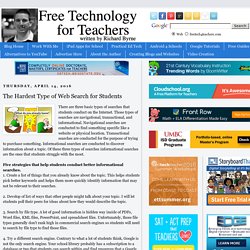
Those types of searches are navigational, transactional, and informational. Navigational searches are conducted to find something specific like a website or physical location. Transactional searches are conducted for the purpose of trying to purchase something. 50 Ideas And Resources For More Visual Learning. 50 Ideas And Resources For More Visual Learning by Terry Heick Though the idea of learning styles has fallen from favor in education circles due to a lack of compelling research data that supports its effectiveness, there’s quite of bit of misunderstanding about it all.
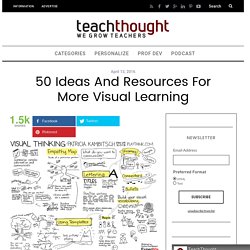
8 Strategies To Improve Executive Functions Of The Brain. 8 Strategies To Improve Executive Functions Of The Brain by TeachThought Staff What are the executive functions of the brain, and what can you do as an educator to support their development in students?
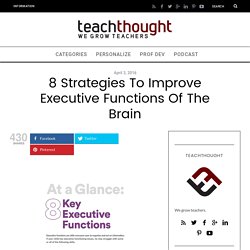
That’s what the graphic below from understood.org seeks to answer. According to Harvard, “Executive function and self-regulation skills are the mental processes that enable us to plan, focus attention, remember instructions, and juggle multiple tasks successfully. 100 Questions That Help Students Think About Thinking. 100 Questions That Help Students Think About Thinking by Terry Heick Last year I wrote a post on how to help students think for themselves.
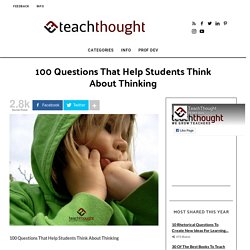
TeachThought reader Peter Duckett wrote me a few months later with these questions below that he added in order to facilitate their use in the classroom. Try the Google Newspaper Archive to Locate Old Articles and Images. You Can Use a Picture If: Guidelines for Image Copyrights – The Visual Communication Guy: Design, Writing, and Teaching Resources All in One Place!
A couple years ago, I published a flowchart on image copyright best practices that followed the question, “Can I Use that Picture?”

While that chart has been widely distributed and used in schools, libraries, and businesses across the country, I have since wondered if it might be clearer to simplify the chart even further. At its most basic level, image usage can be boiled down to four main ideas: copyright, fair use, creative commons, and public domain. If you can wrap your head around around those four concepts, image copyright won’t seem so scary. Literature Map Helps You Find Authors You Might Like. Tech Tip: Create grading shortcuts in Google Documents. More teachers are grading work online these days but many still prefer to grade writing assignments on paper because they can use abbreviations when they edit or quickly write in feedback.

Good news: Google Documents includes a feature that teachers can use to create their own grading shortcuts. Here’s how it works: Open a Google Document in the account you use for school.Click “Tools” at the top of the Google Document and select “Preferences.”Once the “Preferences” window pops up, teachers can create an abbreviation for a comment they use frequently when providing feedback or grading papers. For example, they can write the phrase “awk” in the empty box below the word “Replace” then they can write “awkward–rework for clarity” in the empty box below the word “With.”
Teachers can add, delete or edit grading shortcuts at any time. My Favorite Internet Search Tips for Teachers & Students. Clear Criteria: A Good Way to Improve Participation I continue to be impressed by the need for teachers to clarify common aspects of instruction instead of assuming that students’ understanding of what they entail are the same as ours.
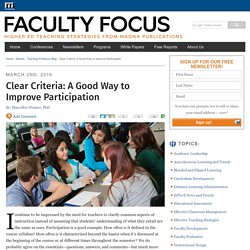
Participation is a good example. How often is it defined in the course syllabus? How often is it characterized beyond the basics when it’s discussed at the beginning of the course or at different times throughout the semester? We do probably agree on the essentials—questions, answers, and comments—but much more than that is needed if classroom interaction is to realize its potential as a student engagement strategy. 20 Strategies for Motivating Reluctant Learners. Kathy Perez has decades of experience as a classroom educator, with training in special education and teaching English language learners. She also has a dynamic style. Sitting through her workshop presentation was like being a student in her classroom.
Help Students Develop Vital Interviewing Skills in Your Classroom. Interviewing subjects isn’t just that thing HR Managers do. In fact, interviewing can be a great form of experiential learning. This is true whether students are the interviewer or the interviewee. In fact, when we encourage students to ask questions of the people they meet, we’re encouraging the development of a wide range of skills, from the social and the emotional to a basic sense of curiosity and a thirst for knowledge. Honing interview schools at school will help students thrive not only in the classroom itself, but also in the job market as they interview for jobs, interview others for those positions, and continually ask questions as they settle into their roles. Here are a few ways to integrate the teaching of these essential, foundational skills into the classroom. Image via Flickr by boellstiftung. How to Create a Progress Chart in Google Sheets.
10 Important Google Search Strategies for Students - A PDF Handout. 18 Epic Productivity Apps to Help You Live Your Dreams. Apps should make you more productive. Not make you feel guilty. Not distract you. They should help you do more than you would have done if you didn’t have it. I’ve picked my most epic productivity apps and given you tips for how these apps truly make me more productive. Share your epic apps and ask questions in the comments. Productivity is not working at 100%. For me, productivity is.